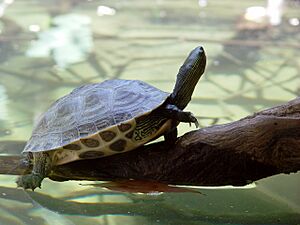Chinese stripe-necked turtle facts for kids
Quick facts for kids Chinese stripe-necked turtle |
|
|---|---|
 |
|
| A Chinese stripe-necked turtle at the San Diego Zoo | |
| Conservation status | |
| Scientific classification | |
| Genus: |
Mauremys
|
| Species: |
sinensis
|
| Synonyms | |
|
|
The Chinese stripe-necked turtle (Mauremys sinensis), also known as the golden thread turtle, is a type of turtle. It belongs to the family Geoemydidae. These turtles live in warm, wet areas of Taiwan and other parts of Asia.
Long ago, people in the Shang dynasty used these turtles for divination. This was a way to predict the future. They found turtle shells from this species far from where the turtles usually live.
Contents
What They Look Like
Young Chinese stripe-necked turtles have a grayish-green shell. They also have three clear ridges on their shell. As they get older, their shell turns more brown. The ridges on their shell slowly disappear.
Their belly, called the plastron, is an ivory color. It has small black spots. Male turtles have a thicker and longer tail. Adult female turtles are usually bigger than the males.
Where They Live
Chinese stripe-necked turtles like to live in low-lying wet places. This includes ponds, canals, and rivers that flow slowly. The climate is very important for them. They need a suitable climate to survive and thrive.
Where They Are Found
You can find the Chinese stripe-necked turtle in China. This includes areas like Hainan, Guangdong, and Fujian. They also live in Taiwan and northern and central Vietnam.
Some baby turtles have been found in Italy. This suggests that some of these turtles might be starting to live in new places.
Protecting Them
The Chinese stripe-necked turtle is a protected species. Organizations like CITES and IUCN help protect them. It is okay to breed these turtles in special care programs.
One problem for their population is the red-eared slider. This is another type of turtle that can take over their habitats. Chinese stripe-necked turtles are also popular pets in places like Hong Kong, mainland China, and Taiwan.
Turtle Families and Hybrids
Sometimes, different types of turtles can have babies together. These babies are called hybrids. This happens a lot with the Chinese stripe-necked turtle.
In special care, they have made hybrids with other turtles. These include the Japanese pond turtle and the Chinese pond turtle. They have also bred with a male Cyclemys (oldhami) shanensis.
Some turtles once thought to be new species are actually hybrids. For example, Ocadia glyphistoma is a hybrid. It comes from a male Chinese stripe-necked turtle and a female Vietnamese pond turtle. The Vietnamese pond turtle is almost extinct in the wild. Another hybrid is Ocadia philippeni. This one is from a male Chinese stripe-necked turtle and a female Cuora trifasciata.
These hybrids can happen naturally or be bred for the pet trade. If you have these turtles as pets, it's important to keep them separate from other turtles. This helps prevent more hybrids from being made.
How They Reproduce
After mating, a female turtle can lay between 5 and 20 eggs. These eggs usually hatch after about 60 days.


